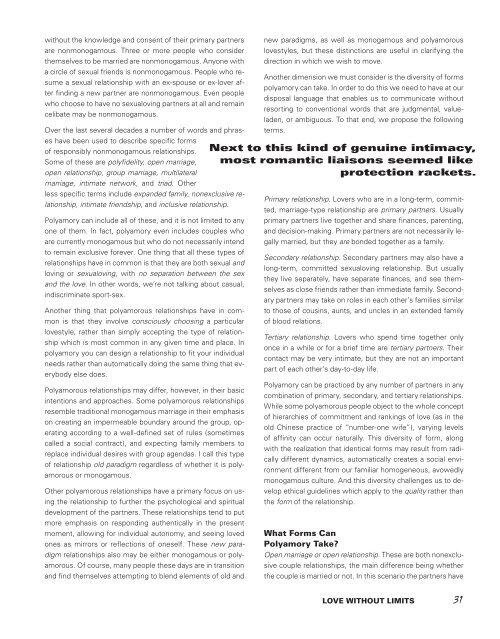You also want an ePaper? Increase the reach of your titles
YUMPU automatically turns print PDFs into web optimized ePapers that Google loves.
without the knowledge and consent of their primary partners<br />
are nonmonogamous. Three or more people who consider<br />
themselves to be married are nonmonogamous. Anyone with<br />
a circle of sexual friends is nonmonogamous. People who resume<br />
a sexual relationship with an ex-spouse or ex-lover after<br />
finding a new partner are nonmonogamous. Even people<br />
who choose to have no sexualoving partners at all and remain<br />
celibate may be nonmonogamous.<br />
Over the last several decades a number of words and phrases<br />
have been used to describe specific forms<br />
of responsibly nonmonogamous relationships.<br />
Some of these are polyfidelity, open marriage,<br />
open relationship, group marriage, multilateral<br />
marriage, intimate network, and triad. Other<br />
less specific terms include expanded family, nonexclusive relationship,<br />
intimate friendship, and inclusive relationship.<br />
Polyamory can include all of these, and it is not limited to any<br />
one of them. In fact, polyamory even includes couples who<br />
are currently monogamous but who do not necessarily intend<br />
to remain exclusive forever. One thing that all these types of<br />
relationships have in common is that they are both sexual and<br />
loving or sexualoving, with no separation between the sex<br />
and the love. In other words, we’re not talking about casual,<br />
indiscriminate sport-sex.<br />
Another thing that polyamorous relationships have in common<br />
is that they involve consciously choosing a particular<br />
lovestyle, rather than simply accepting the type of relationship<br />
which is most common in any given time and place. In<br />
polyamory you can design a relationship to fit your individual<br />
needs rather than automatically doing the same thing that everybody<br />
else does.<br />
Polyamorous relationships may differ, however, in their basic<br />
intentions and approaches. Some polyamorous relationships<br />
resemble traditional monogamous marriage in their emphasis<br />
on creating an impermeable boundary around the group, operating<br />
according to a well-defined set of rules (sometimes<br />
called a social contract), and expecting family members to<br />
replace individual desires with group agendas. I call this type<br />
of relationship old paradigm regardless of whether it is polyamorous<br />
or monogamous.<br />
Other polyamorous relationships have a primary focus on using<br />
the relationship to further the psychological and spiritual<br />
development of the partners. These relationships tend to put<br />
more emphasis on responding authentically in the present<br />
moment, allowing for individual autonomy, and seeing loved<br />
ones as mirrors or reflections of oneself. These new paradigm<br />
relationships also may be either monogamous or polyamorous.<br />
Of course, many people these days are in transition<br />
and find themselves attempting to blend elements of old and<br />
new paradigms, as well as monogamous and polyamorous<br />
lovestyles, but these distinctions are useful in clarifying the<br />
direction in which we wish to move.<br />
Another dimension we must consider is the diversity of forms<br />
polyamory can take. In order to do this we need to have at our<br />
disposal language that enables us to communicate without<br />
resorting to conventional words that are judgmental, valueladen,<br />
or ambiguous. To that end, we propose the following<br />
terms.<br />
Next to this kind of genuine intimacy,<br />
most romantic liaisons seemed like<br />
protection rackets.<br />
Primary relationship. Lovers who are in a long-term, committed,<br />
marriage-type relationship are primary partners. Usually<br />
primary partners live together and share finances, parenting,<br />
and decision-making. Primary partners are not necessarily legally<br />
married, but they are bonded together as a family.<br />
Secondary relationship. Secondary partners may also have a<br />
long-term, committed sexualoving relationship. But usually<br />
they live separately, have separate finances, and see themselves<br />
as close friends rather than immediate family. Secondary<br />
partners may take on roles in each other’s families similar<br />
to those of cousins, aunts, and uncles in an extended family<br />
of blood relations.<br />
Tertiary relationship. Lovers who spend time together only<br />
once in a while or for a brief time are tertiary partners. Their<br />
contact may be very intimate, but they are not an important<br />
part of each other’s day-to-day life.<br />
Polyamory can be practiced by any number of partners in any<br />
combination of primary, secondary, and tertiary relationships.<br />
While some polyamorous people object to the whole concept<br />
of hierarchies of commitment and rankings of love (as in the<br />
old Chinese practice of “number-one wife”), varying levels<br />
of affinity can occur naturally. This diversity of form, along<br />
with the realization that identical forms may result from radically<br />
different dynamics, automatically creates a social environment<br />
different from our familiar homogeneous, avowedly<br />
monogamous culture. And this diversity challenges us to develop<br />
ethical guidelines which apply to the quality rather than<br />
the form of the relationship.<br />
What Forms Can<br />
Polyamory Take?<br />
Open marriage or open relationship. These are both nonexclusive<br />
couple relationships, the main difference being whether<br />
the couple is married or not. In this scenario the partners have<br />
LOVE WITHOUT LIMITS 31


